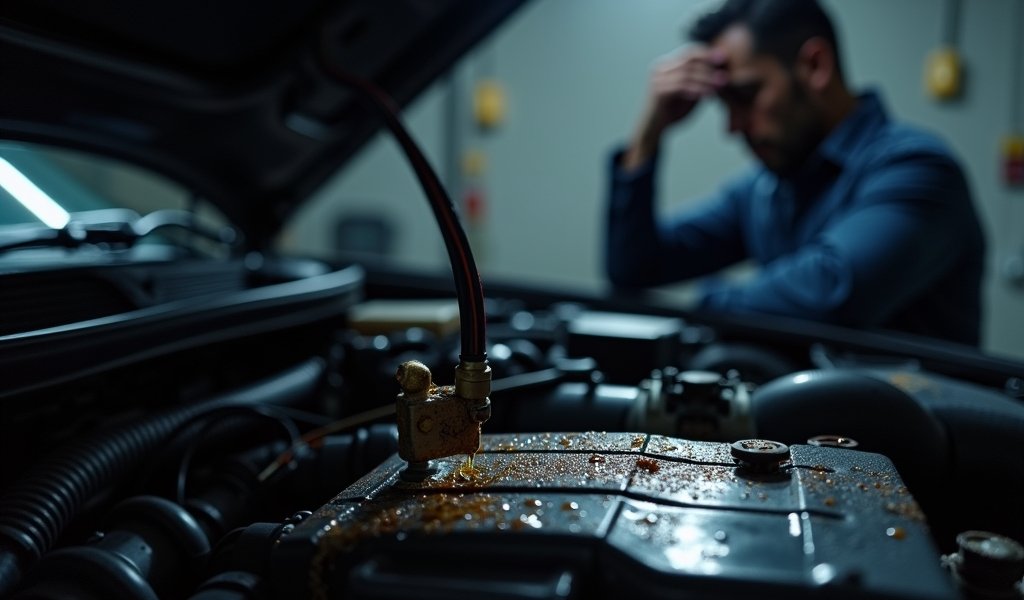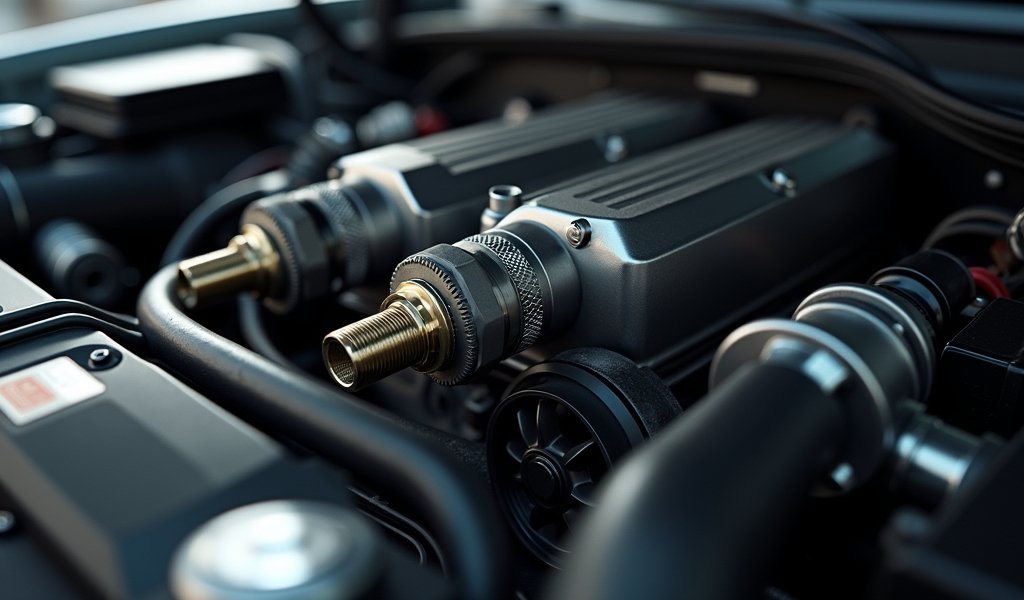Overview
The article explains how the engine oil pressure switch functions as a critical warning system that monitors oil pressure and can prevent catastrophic engine failure when properly maintained. It provides detailed guidance on diagnosing switch problems, proper replacement techniques, and preventative maintenance practices to extend switch life, emphasizing that this small component plays a vital role in protecting your engine’s health.
Table of Contents
- Understanding the Engine Oil Pressure Switch
- The Importance of Oil Pressure in Your Engine
- Symptoms of a Failing Oil Pressure Switch
- Tip #1: Properly Diagnosing Oil Pressure Switch Issues
- Tip #2: The Right Way to Replace Your Oil Pressure Switch
- Tip #3: Preventative Maintenance to Extend Switch Life
- Conclusion
- Frequently Asked Questions
Understanding the Engine Oil Pressure Switch
The engine oil pressure switch is like your car’s tiny health monitor, silently working behind the scenes to keep things running smoothly. Think of it as the vigilant night watchman of your engine’s oil system – always on duty, always alert. This small but mighty component sits quietly in your engine bay, usually screwed into the engine block or oil filter housing, keeping tabs on one of your vehicle’s most vital signs: oil pressure.
At its core, this switch functions much like a bouncer at an exclusive club. When oil pressure drops below the acceptable threshold, it immediately sends an electrical signal to your dashboard, lighting up that dreaded oil pressure warning light. In the grand symphony of your engine’s operation, the pressure switch plays a crucial solo – if you ignore its warning, the entire orchestra could come crashing to a halt.
Most modern vehicles utilize a simple pressure-activated electrical switch. When proper oil pressure is present, the switch remains in one position; when pressure drops, internal components shift, completing an electrical circuit that triggers your dashboard warning. It’s an elegant, time-tested solution that has saved countless engines from catastrophic failure.
The Importance of Oil Pressure in Your Engine
Oil pressure in your engine isn’t just important – it’s absolutely essential for survival. Imagine trying to run a marathon in scorching heat without water. That’s your engine without proper oil pressure. The pressurized oil forms a crucial protective barrier between metal components that would otherwise rub together with devastating consequences.
This liquid gold circulates through your engine like blood through veins, reaching every critical moving part. From your crankshaft position sensor to the furthest valve, oil reduces friction, removes heat, and carries away harmful particles. Without adequate pressure, this life-giving fluid simply can’t reach all the necessary places.
When oil pressure drops, metal begins grinding against metal within milliseconds. The resulting heat and friction can transform your precision-engineered powerplant into expensive scrap metal faster than you can say “check engine light.” According to research from the Society of Automotive Engineers, even brief periods of inadequate lubrication can reduce engine lifespan by thousands of miles.
That’s precisely why your oil pressure switch deserves your attention. This humble sentinel stands as the last line of defense between normal operation and engine destruction. When it speaks, wise car owners listen – and act quickly.

Symptoms of a Failing Oil Pressure Switch
When your engine oil pressure switch starts waving the white flag, it typically doesn’t go quietly into the night. Instead, it broadcasts its distress through several telltale signals that savvy drivers should never ignore. Think of these symptoms as your vehicle’s distress flares – colorful, obvious, and demanding immediate attention.
The most obvious sign is an illuminated oil pressure warning light dancing on your dashboard. This little red genie isn’t granting wishes – it’s warning of potential disaster. Sometimes it might flicker like a candle in the wind, especially during idling or when taking corners. This inconsistent behavior often points directly to a failing switch rather than actual pressure problems.
Another common symptom is the “boy who cried wolf” scenario – false alarms when your oil level and pressure are actually perfectly fine. You check the dipstick, everything looks golden, yet that stubborn light persists. This happens when the switch itself becomes faulty, sending incorrect signals to your car’s computer.
In some cases, you might notice the exact opposite problem – no warning despite dangerously low oil pressure. This situation is particularly treacherous, like having your smoke detector fail during a fire. If you observe unusual engine noises (particularly ticking or knocking) coupled with declining performance, don’t wait for the light – check your pressure manually.
Oil leaks around the switch itself often signal trouble brewing. The switch has its own gasket or sealing mechanism that can deteriorate over time, creating a slow but persistent oil weep. These leaks typically appear as dark stains on the engine block near the switch location.
Perhaps the most perplexing symptom is erratic electrical behavior elsewhere in your vehicle. A failing switch can sometimes cause strange electrical issues, from flickering dashboard lights to inconsistent gauge readings. This happens because the faulty switch creates electrical feedback through your vehicle’s sensor network, much like static in old telephone lines.
Tip #1: Properly Diagnosing Oil Pressure Switch Issues
Before you start throwing parts at the problem like confetti at a parade, take a methodical approach to diagnosis. False alarms and genuine pressure problems can look remarkably similar, and distinguishing between them requires a detective’s mindset.
First, perform the simplest check: verify your actual oil level using the dipstick. This might seem obvious, but many a red-faced mechanic has replaced a perfectly good pressure switch only to discover the real culprit was simply low oil. While you’re at it, examine the oil’s condition – if it resembles chocolate milk or contains visible metal flakes, you’re dealing with more serious issues than just a switch problem.
Next, consider using an actual pressure gauge to test your engine’s true oil pressure. This test separates fact from fiction with clinical precision. Here’s how to do it:
- Locate your oil pressure switch (usually near the oil filter)
- Carefully remove the switch (have a pan ready to catch oil)
- Install a mechanical oil pressure gauge in its place
- Start the engine and observe the reading at idle and at 3,000 RPM
- Compare your findings with your vehicle’s specifications
If the gauge shows healthy pressure (typically 30-60 PSI at operating temperature), yet your warning light was illuminated, you’ve caught your culprit red-handed – the switch needs replacement. Conversely, if the gauge confirms low pressure, you need to investigate deeper issues like a worn oil pump, clogged pickup, or internal engine damage.
For those with access to a multimeter, electrical testing provides another valuable diagnostic avenue. With the engine off and the switch connector unplugged, check for continuity between the switch terminals with the switch both installed and removed. The readings should change depending on whether pressure is applied. This test works similarly to checking your knock sensor resistance – it’s all about proper electrical values.
Remember, diagnostic patience pays dividends. As one veteran mechanic colorfully puts it: “Measure twice, replace once – or you’ll be buying parts ’til your wallet runs dry.”
Tip #2: The Right Way to Replace Your Oil Pressure Switch
Replacing your engine oil pressure switch isn’t rocket science, but it does demand attention to detail. Think of it as performing minor surgery – you need the right tools, a clean environment, and a careful touch. With some patience and these guidelines, you can tackle this job in your driveway and save yourself a pretty penny.
Before you begin, gather your supplies like a chef prepping for a gourmet meal. You’ll need the correct replacement switch (vehicle-specific), the appropriate socket (often a deep socket or special oil pressure switch socket), ratchet, extension, thread sealant (if not pre-applied), and plenty of rags. Having everything within arm’s reach prevents the dreaded mid-job parts store run.
Now, let’s walk through the replacement process step by step:
- Ensure your engine is completely cool – working on a hot engine is like juggling fire
- Locate the switch (check your service manual if you’re playing hide-and-seek)
- Disconnect the electrical connector (sometimes requiring a small flathead screwdriver)
- Position your oil catch pan strategically – some oil spillage is inevitable
- Remove the old switch using the proper socket and extension
- Compare the new switch to the old one – they should be identical twins
- Apply thread sealant if needed (follow manufacturer guidelines)
- Hand-thread the new switch carefully to avoid cross-threading
- Tighten to specification – usually about 12-15 ft-lbs (check your manual)
- Reconnect the electrical connector until it clicks securely
After installation, start the engine and watch for leaks like a hawk watches for field mice. The connection should be bone-dry. If you see even a hint of seepage, shut down immediately and check your work. A properly installed switch doesn’t leak – period.
One critical note from Motor Magazine’s technical service: over-tightening is the silent killer of oil pressure switches. These components have precise torque specifications for a reason. Too tight, and you risk damaging the switch or, worse, cracking the engine block’s threaded port. When in doubt, consult your service manual for the exact torque specification.

Tip #3: Preventative Maintenance to Extend Switch Life
Prevention truly is worth a pound of cure when it comes to your oil pressure switch. Like tending a garden, a little regular attention yields bountiful rewards. Most switches should last 50,000-100,000 miles, but with these practices, you might never need to replace yours at all.
Regular oil changes are the cornerstone of pressure switch longevity. Fresh, clean oil is to your switch what clear water is to a fish – essential for survival. Dirty oil contains abrasive particles that can scratch the switch’s internal components and accelerate wear. Follow your manufacturer’s recommended oil change intervals religiously, or even exceed them if you drive in harsh conditions.
The type of oil you choose matters tremendously. Modern engines, particularly those with variable valve timing or turbocharged systems, require specific oil viscosities and ratings. Using the wrong oil is like putting diesel in a gasoline engine – technically a liquid fuel, but disastrously incorrect. Your owner’s manual spells out exactly what your engine needs, from viscosity (like 5W-30) to service ratings (such as API SN).
Monitor your engine coolant temperature sensor readings as well. Excessive heat is kryptonite to electrical components like your pressure switch. If your engine runs consistently hot, address cooling system issues promptly. Similarly, extremely cold weather can affect oil pressure readings, so allow proper warm-up time during winter months.
Consider adding a switch inspection to your annual maintenance ritual. Simply checking the connector for corrosion or damage and ensuring the switch body shows no signs of seepage can catch problems before they escalate. A visual inspection takes mere minutes but can save hours of future trouble.
For the truly dedicated, installing an aftermarket oil pressure gauge provides two benefits: it gives you real-time pressure readings and serves as a backup to your factory switch. Think of it as wearing both a belt and suspenders – perhaps excessive, but guaranteed to keep your pants up!
Lastly, address check engine lights promptly, even if they seem unrelated to oil pressure. Modern engines are integrated systems where one problem often cascades into others. That innocent-looking oxygen sensor code might be indirectly affecting your oil pressure switch’s performance.
Conclusion
Your engine oil pressure switch may be small in size, but its importance to your vehicle’s health is immeasurable. Like the canary in a coal mine, it provides vital early warnings that can save you from catastrophic engine failure and expensive repairs. By understanding how it works, recognizing the symptoms of failure, and following our three proven tips for diagnosis, replacement, and prevention, you’re now armed with the knowledge to keep this critical component performing perfectly.
Remember that proper oil pressure isn’t just another parameter – it’s the lifeblood of your engine. The humble pressure switch stands guard over this vital function day in and day out. Treating it with the respect it deserves through proper maintenance and prompt attention to warning signs will reward you with thousands of trouble-free miles.
The next time your oil pressure light flickers to life, you won’t panic. Instead, you’ll methodically work through the diagnostic steps, confidently determine if the switch itself or a deeper issue is at fault, and take appropriate action. That’s the power of knowledge – turning potential disasters into simple maintenance tasks.
Drive safely, maintain wisely, and may your oil pressure always remain perfectly nominal!
Frequently Asked Questions
How much does it cost to replace an oil pressure switch?
The part typically costs $15-50, while professional installation adds $50-100 in labor. DIY replacement costs only the price of the part and about an hour of your time.
Can I drive with a bad oil pressure switch?
It’s not recommended as you won’t know if you’re experiencing actual dangerous low oil pressure. If your switch is giving false readings, get it replaced as soon as possible.
Where is the oil pressure switch located?
It’s usually threaded into the engine block or oil filter housing. Most vehicles have it near the oil filter or on the cylinder head.
How do I know if my oil pressure switch is bad or if I have actual low oil pressure?
Check your oil level first, then consider installing a mechanical gauge to test actual pressure. If oil level is good and a gauge shows normal pressure, the switch is likely faulty.
How often should an oil pressure switch be replaced?
There’s no scheduled replacement interval as they typically last 50,000-100,000 miles. Replace it when it shows signs of failure or leakage.

